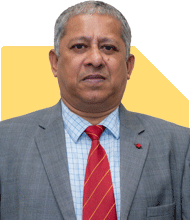35-Year-Old with 120k Income & 20 Lakh Insurance Wants to Retire at 50: How to Reach the Goal?
Ramalingam Kalirajan |8459 Answers |Ask -Follow
Mutual Funds, Financial Planning Expert - Answered on Jul 26, 2024
He has an MBA in finance from the University of Madras and is a certified financial planner.
He is the director and chief financial planner at Holistic Investment, a Chennai-based firm that offers financial planning and wealth management advice.... more

Hi sir, I am 35years old.i have 5year old son.my salary and my wife it's 120000, Total medical insurance is 20lack. Pf 9000 per month mutual fund 11000 per month and I have a flat of 65lack.i want to retire at 50.
Income: Combined salary of Rs 1,20,000 per month.
Medical Insurance: Coverage of Rs 20 lakhs for your family.
Provident Fund: Rs 9,000 per month.
Mutual Fund Investment: Rs 11,000 per month.
Property: Own a flat valued at Rs 65 lakhs.
Son's Age: 5 years old.
Retirement Planning
Goal: Retire at age 50. This gives you 15 years to build a retirement corpus.
Corpus Needed: You need a substantial corpus to sustain post-retirement. This includes living expenses, medical needs, and inflation.
Investments Assessment
Provident Fund: Stable and secure. Continue contributing.
Mutual Funds: Good choice for long-term wealth creation. Ensure you have a diversified portfolio.
Property: Avoid considering it as a liquid asset for retirement. Focus on financial instruments instead.
Increasing Investments
Enhance SIPs: Increase SIP contributions gradually. Aim for a higher monthly investment.
Equity Exposure: Ensure a good mix of equity mutual funds. Equity offers higher returns over the long term.
Debt Funds: Balance your portfolio with some debt funds for stability.
Insurance Review
Medical Insurance: Rs 20 lakhs is decent coverage. Review it periodically to ensure it meets future needs.
Life Insurance: Ensure adequate life cover. Consider term plans for sufficient coverage.
Education Fund for Son
Higher Education: Start a dedicated fund for your son's higher education. Education costs will rise significantly.
Investment Options: Use a mix of child plans and mutual funds to build this corpus.
Reducing Debt
Home Loan: If you have a home loan on your flat, plan to repay it before retirement.
Debt-Free Retirement: Aim to enter retirement without any liabilities.
Professional Guidance
Certified Financial Planner: Consult a Certified Financial Planner for a detailed plan. They can help you balance risk and return.
Regular Reviews: Periodically review your financial plan. Make adjustments based on life changes and market conditions.
Final Insights
Consistent Savings: Regular and disciplined savings are key to achieving your goals.
Balanced Portfolio: Maintain a balanced portfolio to manage risks.
Focus on Long-Term: Keep a long-term perspective for investments. Avoid short-term market fluctuations.
Emergency Fund: Ensure you have an emergency fund. It should cover at least 6 months of expenses.
Best Regards,
K. Ramalingam, MBA, CFP,
Chief Financial Planner,
www.holisticinvestment.in
You may like to see similar questions and answers below
Ramalingam Kalirajan |8459 Answers |Ask -Follow
Mutual Funds, Financial Planning Expert - Answered on Jun 19, 2024
Ramalingam Kalirajan |8459 Answers |Ask -Follow
Mutual Funds, Financial Planning Expert - Answered on Jul 08, 2024
Ramalingam Kalirajan |8459 Answers |Ask -Follow
Mutual Funds, Financial Planning Expert - Answered on Jul 10, 2024
Ramalingam Kalirajan |8459 Answers |Ask -Follow
Mutual Funds, Financial Planning Expert - Answered on Feb 07, 2025
Dr Nagarajan J S K |406 Answers |Ask -Follow
NEET, Medical, Pharmacy Careers - Answered on May 16, 2025

Based on my understanding, no one usually requests a birth certificate at this age. Your inquiry relates to the period before and after independence. In those days, they would accept the SSLC book if you didn't have a birth certificate. However, I am not sure if that was the case during your time.
Instead, you can present your Aadhaar card, which likely includes your original date of birth. You can utilize that information.
If my response doesn't fully address your concerns, I recommend consulting a Notary Public for further assistance.
BEST WISHES.
THANK YOU SIR.
with regards
Prof Suvasish Mukhopadhyay |651 Answers |Ask -Follow
Career Counsellor - Answered on May 16, 2025
Prof Suvasish Mukhopadhyay |651 Answers |Ask -Follow
Career Counsellor - Answered on May 16, 2025
Radheshyam Zanwar |1634 Answers |Ask -Follow
MHT-CET, IIT-JEE, NEET-UG Expert - Answered on May 16, 2025
Radheshyam Zanwar |1634 Answers |Ask -Follow
MHT-CET, IIT-JEE, NEET-UG Expert - Answered on May 16, 2025
Ashwini Dasgupta |107 Answers |Ask -Follow
Personality Development Expert, Career Coach - Answered on May 16, 2025
Ramalingam Kalirajan |8459 Answers |Ask -Follow
Mutual Funds, Financial Planning Expert - Answered on May 16, 2025
Ramalingam Kalirajan |8459 Answers |Ask -Follow
Mutual Funds, Financial Planning Expert - Answered on May 16, 2025
Milind Vadjikar |1236 Answers |Ask -Follow
Insurance, Stocks, MF, PF Expert - Answered on May 16, 2025
Milind Vadjikar |1236 Answers |Ask -Follow
Insurance, Stocks, MF, PF Expert - Answered on May 16, 2025























